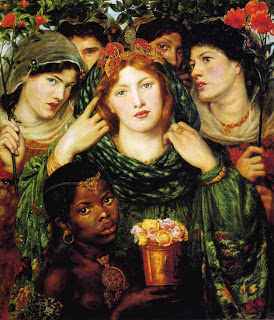
“For I am the first and the last.
I am the honored one and the scorned one.
I am the whore and the holy one.
I am the wife and the virgin…
I am the barren one, and many are her sons.
I am the silence that is incomprehensible…
I am the utterance of my name.”
The above poem – musings from the Divine Feminine – is excerpted from “Thunder, Perfect Mind,” one of the 52 Gnostic texts discovered at Nag Hammadi in Egypt in 1945. The image (above left) is of Gabriel Rossetti’s “The Beloved,” his artistic rendition of a theme from the Canticle of Canticles.
From the Gospel of Philip, another Gnostic text:
“The companion of [the savior] is Mary Magdalene. But Christ loved her more than [all] the disciples and used to kiss her [often] on her [mouth]. The rest [of the disciples were offended] … They said to him, ‘Why do you love her more than all of us?'”
Companion in this context means wife.
The version of Christianity that has filtered down to us today is quite different than the Gnostic version, which dates to the second century when both versions were nascent. Orthodox (“straight-thinking”) Christians and Jews regard God as “wholly other” and distinctly separate from humanity and creation. The Gnostics, however, believe in the “intuitive knowledge of Self,” which, in fact, is the definition of gnosis. They regard knowledge of Self and knowledge of the Divine to be one and the same; to know thy Self is to know the Divine that dwells within.
Separatism, particularly in monotheistic religions, is expressed using terms such as us and them, with them often being marginalized, and even demonized. Holism, particularly in Gnostic and Eastern religion, is expressed in terms such as one and all where everything in the cosmos, both matter and spirit, is seen as being interconnected and interdependent, including the Divine pleroma, the totality of divine emanations. Martin Buber’s expression “wholly other” becomes starved of its meaning.
The Gnostics spoke in terms of enlightenment and of the illusions of the world, not of sin and repentance. The Gnostic Jesus was a human being, “a guide who opened access to spiritual understanding,” wrote Elaine Pagels in her seminal work The Gnostic Gospels. (Highly recommended!)

In the Gnostic Gospel of Thomas, Jesus says: “If you bring forth what is in you, what you bring forth will save you. If you do not bring forth what is in you, what you do not bring forth will destroy you.”
This sounds somewhat like Jungian shadow work: “Until you make the unconscious conscious it will direct your life and you will call it fate,” wrote Jung.
The message of our androgynous Divine Child, and Chrysalis Tarot’s overarching theme, is that we find the important answers inside us. They aren’t “out there” somewhere. Tarot decks like Chrysalis that honor the holistic, interconnected worldview of the Gnostics “bring forth what is in you” by assisting with spiritual growth and by increasing self-knowledge via tarot’s Hero’s Journey, and by encouraging use of active imagination and intuition.
Like Gnosticism, the Chrysalis worldview does not hold sacred a parroted catalog of “correct beliefs” (dogma) that passively lead to salvation. We hold as sacred spiritual practices that lead instead to pathways of self-discovery, self-knowledge and empowerment. In addition to tarot, such spiritual practices might include yoga, chakra work, meditation, holotropic breathwork, reiki, or any number of other modalities that actively promote healing, self-knowledge and spiritual transformation.
We don’t need to be saved. We need to be transformed.
For this piece, I purposefully did not choose a well known painting of Mary Magdalene. Far too many of them picture her holding an alabaster jar, a symbolic reference to Luke’s unnamed sinful woman (prostitute) who washed Jesus’ feet. That was not Mary Magdalene! (Jesus washed the feet of the disciples on Maundy Thursday, which by the way is celebrated today, March 24.)
This tawdry injustice to Mary, a misogynist theological fiction, can be directly traced to a sermon delivered by Pope Gregory in 591. His error confusing Mary Magdalene with a prostitute was eventually acknowledged by the Vatican in 1969, although a lot of preachers and filmmakers apparently never read the press release.
Our Mary Magdalene is an enlightened Alleluia woman, both emanation and exemplar of the Divine Feminine that dwells within. She is the “honored one and the scorned one.”
Our Mary Magdalene is the beloved wife and disciple of Jesus Christ.

Still from the film, The Da Vinci Code.

Extraordinary! Thanks for the information.
LikeLike